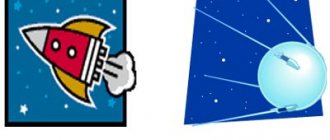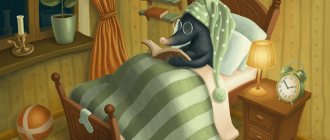It's a disaster when children get sick. Their fragile body is struggling, and we are trying our best to help the child: we examine him with the best specialists, get effective medicines, and try to ensure peace.
All this is correct in the complex course of the disease. However, there are still a number of points that escape our attention. Thus, the psychophysiological characteristics of the child’s body play a very important role. And this means that recovery largely depends on the psycho-emotional state of the child. If in adults more than 70% of diseases have a psychosomatic basis, i.e. are the body’s reaction to our emotional problems, then children often “respond” with illness to the anxiety and concern of their parents. And this is exactly the state we find ourselves in when children are sick. This negative emotional background interferes with recovery.
Another feature of a child’s body is the constant growth of organs. Consequently, those muscles to which a stronger blood flow is directed, i.e., to organs that are in motion, develop more intensively. In addition, it is known that the muscular system in early life is closely related to the main regulatory mechanisms. Limited movement negatively affects not only the diseased organ, but also the nervous, endocrine and neurotransmitter systems as a whole. Restriction of movements (the child is sick or has just recovered and needs rest) affects posture, weakens the functions of breathing and blood circulation. Passivity in movement leads to a decrease in the flow of irritations perceived by the nerve endings of the skin, muscles, joints, in the visual and auditory analyzers, going to the cerebral cortex. As a result, disorders of the central nervous system and internal organs may develop: emotional tone decreases, the neuromuscular system is weakened, and the cardiovascular and respiratory systems work weaker. This means that the body as a whole is weakened, which leads to more frequent diseases.
These observations about the role of movement in human development and health are reflected in an entire field of medicine - therapeutic and preventive physical education. However, the child’s psyche, especially at an early age, is structured in such a way that it is almost impossible to force the child to purposefully perform any, even the most useful, exercises. The child should be interested in studying. That is why we present adapted, game-based exercises for health improvement and disease prevention. Their effect is not only in the treatment of children, such games-exercises contribute to comprehensive, harmonious physical and mental development, the formation of necessary skills, coordination of movements, dexterity and accuracy.
During the game, unexpected, funny situations often arise. This causes sincere joy in both children and parents. A relaxed, cheerful atmosphere does not allow the child to “go away” into illness, allows parents to show more attention to him and increases joint communication with children in an atmosphere of love and care. This is a very powerful therapeutic factor.
It should be noted that the healing effect of games is possible only with frequent and long-term exercise (3 - 4 months, 2 - 3 times a day).
Games for diseases of the cardiovascular system
“Finger on finger”
Goal. Balancing nervous processes, strengthening inhibitory reactions, performing actions on command, coordinating hand movements.
Progress of the game. The child is sitting in front of you. He repeats your movements to your song:
Finger on finger, knock and knock, (Repeat 2 times)
Clap, clap, clap, clap! (Clap their hands)
Stomp your feet, stomp! (Repeat 2 times)
Hid, hide (Cover your face with your hands)
Finger on finger, tap and tap. (Repeat 2 times).
“Corrective and recreational games” (consultation for parents)
Consultation for parents on the topic:
"Corrective and recreational games"
The goal is to involve the family in preparing to improve the pedagogical culture of parents in matters of healthy lifestyle, familiarization with games and exercises to improve the health of children, and dissemination of family experience in leading a healthy lifestyle.
It is necessary not only in kindergarten, but also at home in everyday life to create the necessary conditions for the correct full physical development of the child:
general strengthening of the body (rational nutrition, prolonged exposure to fresh air, varied physical activity,
· choosing the right shoes for a child,
· massage,
· carrying out hardening procedures (barefoot walking on various surfaces, foot baths),
· special exercises to strengthen the muscles of the feet and toes,
· use of foot exercise equipment, including non-traditional equipment that can be easily made at home, and much more. etc.
Games for developing correct posture
The basis for the prevention and treatment of poor posture is general training of the child’s body. The objectives of the games include: strengthening the musculoskeletal system, strengthening the muscular “corset” of the spine, improving respiratory functions and the cardiovascular system.
Game "Visiting the Bear"
Having placed a bear toy on a high cube and made a slide from a long board placed on a gymnastics wall, the adult says:
Nastya (child's name) and Seryozha
They often go down the hill to see the bear.
The child enters the slide (you can use the slide on the playground in the yard, you just need to be careful and help the child climb to a height of about a meter), then runs down it and runs up to the bear, pets it and sits down to rest. An adult needs to carefully monitor the child's posture.
Purpose of the game: development of dexterity, speed of reaction and movement, sense of balance, coordination of visual and auditory analyzers, stable attention.
Game "Swing-carousel"
Parents lift the child in a supine position to the level of their waist. One holds the child under the armpits, the other - by both legs, and swings him in an upright position with the words: “Swing, swing, swing.” Then one of the adults continues to hold the child under the arms (the other lets go) and spins with him to the right and left (it turns out to be a carousel) with the words: “The carousels have flown.” It is advisable to play the game with rhythmic music. The game is played in the final phase of classes, when the child feels tired.
Purpose of the game: relaxation of the trunk muscles, improvement of the vestibular apparatus.
Health games for diseases of the nose and throat
For diseases of the upper respiratory tract, it is necessary to restore nasal breathing. With rhythmic, full exhalation, nasal breathing, the respiratory muscles are better relaxed and the smooth muscles of the bronchi are reflexively relaxed. When playing games with children, it is necessary to simultaneously monitor the correct posture and lip closure.
Game Owl-Owl"
Children sit in a semicircle in front of an adult. At the adult’s signal “day,” the “owl” children slowly turn their heads left and right. At the signal of night, the children look forward and flap their arms - “wings”. Lowering them down, they say protractedly, without tension: “U-ufff.” Repeat two to four times.
Purpose of the game: development of hand correction with respiratory movements of the chest, improvement of breathing functions (deep exhalation).
Games for flat feet
Flat feet most often occur in weak, physically poorly developed children. Often the load on the arches of the feet of such children is excessive. The ligaments and muscles of the foot become overstrained, stretched, and lose their springy properties. The arches of the feet flatten, droop, and flat feet occur. Therefore, games should be selected in such a way that the exercises strengthen the ligamentous-muscular apparatus of the lower leg and foot, contribute to the overall health of the body and develop the skill of proper walking.
Game “Bring it, don’t drop it”
The players sit on chairs. Everyone has a sheet under their feet. You need to grab the sheet with your toes and drag it in any way (jumping on one leg or all fours) to the opposite end of the hall. Repeat the same with the other leg. The one who does it faster without dropping the sheets wins.
Purpose of the game: strengthening the muscular-ligamentous apparatus of the feet, developing dexterity.
Indications for use of the method
For small children, everything is a game. Therefore, it is impossible to highlight significant evidence, since games are the main leisure time for children. When children play, they are in a good mood and do not regard it as something unpleasant and repulsive. Game therapy products are effective in the following cases:
- phobias;
- unsociability, isolation;
- aggression towards others and animals;
- disobedience or excessive obedience;
- problems in relationships with parents, brothers and sisters, etc.;
- retardation in speech development;
- bad habits (for example, chewing a pencil while drawing);
- constant stress;
- problems with academic performance;
- problems with reading. Source: O'Connor K. Theory and practice of play psychotherapy. - St. Petersburg, 2002.
Health games for primary and secondary school students.
Health games for elementary school students
and middle management.
Explanatory note.
These games can be used in lessons, during classes in an extended day group, during summer holidays in a health camp.
They help maintain the children’s motor mode and good posture.
This can be done both in the gym and outdoors. Each game can be diversified and new elements can be added.
1. “Tick-tock”
In a cross-legged position, the child sits with a straight back, hands on his knees. On a signal, shakes his head back and forth, right and left, saying “tick-tock”
" The teacher controls the child's posture.
2. "Swallow"
The student stands on one leg, the other is laid back, arms to the sides, torso tilted forward, head raised. The teacher holds the child by both hands (hereinafter one) and controls whether the spine is correctly straightened and the leg is raised. The pose is first held for no more than 1 second, and then the supporting leg changes.
3. "Ball Rolling"
Children roll balls or balls towards one another or towards the teacher. The rolling path gradually increases.
4. "Pass the ball"
The child sits on the floor, resting his hands behind him. The ball is placed at the feet on the right. Grab it with your feet, lift it and move it to the left.
5. “Jump into a circle”
Three circles are drawn near the stump (bench): one very close, the other further away, the third even further away. Children take turns jumping from a stump into a circle. The winner is the one who aims more accurately at each of the circles and does not fall. You need to jump off softly, springing on your toes.
6. "Balloons"
Children throw inflated balloons over a rope. They play in pairs.
7. "Between the Pins"
Set up the pins. The child walks around the pins placed in a row with a snake. The winner is the one who doesn't knock down any pins. You can walk between the pins with your eyes closed. You can crawl on your belly between
pins without hitting them. The same on all fours. You can play in teams.
8. “Whose jump is more beautiful?”
Competitions can take place between two children or several pairs. One child can also play, testing himself on the quality of the jump. You can jump standing in place, with both feet, on the move, while running, on your left, on your right foot, jump together, with your face and back of your head facing each other. The teacher doses the load according to the condition of the children. Noting the quality of the movement, the teacher says: “Whose jump is more beautiful?” Who could jump more beautifully?” Controlling correct posture.
9. "Obedient Ball"
Lying stretched out on your back, hold the ball between your legs. Turn onto your stomach without dropping the ball. Repeat 4 – 6 times.
What an obedient ball!
I tucked it between my legs.
Turn around and look back!
Ball, don't roll to the floor
!
10. “Who is more resilient?”
At a distance of 50 cm from each other, draw two circles with a diameter of approximately
25 cm. Two players stand on their left foot in their circle and try to move their opponent with their right foot. He loses. Who could not resist and touched the floor with his right foot.
11. "Smart Guys"
Children stand or sit. This game can be played by two to three students competing in agility (who can crawl under the rope or quickly climb over it without hitting it.) The game can be played in teams.
12. “Dancing Cossack”
The child, in a squat, throws one leg forward and places it on the heel. Then he changes the position of his legs. Later, with the help of an adult or leaning on a chair, he smoothly changes the position of his legs by jumping.
13. "Giant"
Walk, rising on your toes as high as possible. ( 45 minutes)
14. "Dwarf"
Walk, rising on your toes, bend your knees. (5 – 7 minutes)
15. "Horse"
Move in a circle, imitating the horse's pace at different paces: walk, trot, gallop (4 - 5 minutes).
16. "Migration of Birds"
Children run after each other and, waving their hands, imitate flying birds. At the signal from the teacher or presenter “wind, storm,” they climb the gymnastics wall. At the signal “good weather”, children run around the hall, and when the signal “wind, storm” is repeated, they again look for a place on the gymnastics wall. The one who took a place on the gymnastic wall at the first signal must find a new place at the second signal. The game is repeated several times. Finally, all children should adopt correct posture. And the teacher controls the quality of the exercise.
17. “Posture control”
At the teacher’s suggestion, the child approaches the wall without a plinth, takes the correct posture: arms down, back of the head, shoulder blades, buttocks, heels firmly touching the wall, head straight, neck vertical, gaze directed forward, lips closed, shoulders slightly lowered, shoulder blades at the same level flattened, the front surface of the chest is turned out, the stomach is slightly tucked, the buttocks are tense, the knees are straightened. Sliding along the wall with the backs of the hands, they raise their arms slightly, their fingers spread apart, like a Christmas tree’s needles, tense. In the “doll” pose, move 3–4 steps away from the wall
(the pose is tense), then lower your arm freely, but keep your entire torso and head straight, walk 1-2 steps around the hall, maintaining correct posture. Children who managed to do the entire “posture control” task better are noted.
18. “Stretched out - curled up”
While lying on his back, the child raises his hands behind his head and stretches out as much as possible. Then, raising the upper half of the body to the knees, leans forward, i.e. groups itself, clasping its legs under the knees. Repeat 2 – 6 times. Between each repetition, rest, lie down like a rag doll, relax.
19. “My cheerful ringing ball...”
Children sit or stand at a distance of 1 meter from each other. They are given small balls. Together with the teacher or presenter, the children hit the ball on the floor and catch it with one hand to the poem:
My cheerful ringing ball,
Where did you go at a gallop?
Red, yellow, blue.
Can't keep up with you.
Then they pass it to each other one by one. Whoever dropped the ball is out of the game. The rest of the children start the game again. Play 2 – 3 times. The teacher monitors correct posture.
20. "Carousel"
Children stand in a circle with hoops. Everyone holds on to their hoop and their friend’s hoop. It turns out to be a big vicious circle. At the signal “let’s go!”
everyone starts moving at a pace; at the signal “run!” everyone runs at the signal
"jumping!"
begin to jump, putting one foot to the other (i.e., side gallop).
To the words “Hush, hush, don’t rush.
Stop the carousel!” start walking calmly and stop.
When the teacher says “ let’s rest!”
everyone puts the hoops on the floor and disperses in different directions, away from the lying hoops. Hearing the signal
“The carousel is starting!
", everyone runs to the hoops, quickly takes them and the game repeats.
21. "Swing"
Children lie or sit on the floor, legs extended. At a signal, the teacher swings their feet to the sides (right and left). They bend and unbend. Repeat 2 – 6 times.
22. "Ball School"
1) Throw the ball up, clap your hands behind your back and catch the ball.
2) Throw the ball up, turn around and catch the ball.
3) Throw the ball up. Sit cross-legged. And catch the ball.
4) Squat down, throw the ball up, jump to your feet and catch the ball.
5) Throw the ball high up, bend over, touch the tips of your fingers to your toes, straighten up and catch the ball.
6) Hit the ball on the ground or floor so that it bounces high, then bend down. Touch the tips of your fingers to your toes and, straightening up, catch the ball.
7) Hit the ball hard in front of you on the ground or floor, turn around and catch the ball.
 Raise your right leg, extending it slightly forward, and throw the ball with your left hand on the ground or floor so that it passes under your right foot. Then catch the bounced ball from the right without lowering your feet. Do the same exercise by lifting your left leg and throwing the ball with your right hand.
Raise your right leg, extending it slightly forward, and throw the ball with your left hand on the ground or floor so that it passes under your right foot. Then catch the bounced ball from the right without lowering your feet. Do the same exercise by lifting your left leg and throwing the ball with your right hand.
9) Draw a circle on the ground, run around it 3 times, hitting the ball with the palm of one hand (either right or left).
23. “Bridge over the river”
Sit on the floor, stretch your legs, lean on your palms behind your body. Bend forward and upward, raise your pelvis, resting on your heels and hands (make a bridge).
Return to standing position, get on all fours, run 5 meters. Repeat
4 – 6 times.
Bridge, bridge across the river -
It was I who took the place.
Became a bridge over the river,
Soon I'll run down the river
The game can be a team game. Competitions can be held between teams for quality and speed of execution.
24. "Fish"
The players are standing. A pond is outlined - an area beyond which you cannot go. The children smoothly spread their arms: “The fish are swimming.” Two “fishermen” stretch the rope - the “net” and try to twist and catch the “fish”. The “fishes” dodge. Those touched by the jump rope leave the game. When all the “fish” are caught, the game is repeated with new “fish”, which are assigned to the most dexterous children.
Oz preschool games for primary and secondary school students
compiled by physical education teacher, life safety teacher and life safety organizer V.V. Shavrin based on materials from publications from different years. Personal materials were also used.
Types and forms of play therapy
Depending on the psychological principles, the following types of techniques are distinguished:
- to build relationships;
- individual;
- group;
- response;
- primitive;
- and etc.
Depending on the toys used and the characteristics of the techniques, there are many types of play therapy. Let's look at the main ones:
- Sand . Its goal is to allow the child to open up; this technique is most effective when working with children with mental development delays. Sand play therapy promotes the development of imagination, emotions, fine motor skills, speech, it allows you to overcome fear, aggression, excessive activity, and anxiety. You can read more in our separate article about sand therapy.
- Fairy tale therapy . The general characteristic of such play therapy is treatment with a fairy tale. One of the most effective and accessible methods for correcting a child’s behavior and consciousness. In this type of therapy, therapeutic fairy tales are read to children. These are special stories that illustrate the experiences and problems of a child, his difficulties in everyday life, and also contain instructive conclusions and unobtrusive morals. Thanks to fairy tale therapy, the child sees that there are many ways to achieve his goal, solve seemingly difficult problems, his creative potential is revealed, self-confidence and self-control appear. Such therapy can be carried out on children from a very early age, when they already understand speech. For older children, the plots become more complex.
- Puppet therapy . A method of treatment with dolls, used to develop self-expression, correct relationships with parents, and self-regulation.
- Relationship therapy . The main thing is to approach the child as an individual who can control himself and has an impressive reserve of internal strength. Children learn to understand their feelings, thoughts, experiences, and recognize themselves as loved and loving people.
- Chess therapy . It is creativity, competition, and learning strategies at the same time.
Game therapy products
The presence of an adult who will be the leader is required - a parent, a play therapist. The presenter provides the child with tools so that he can open up in a playful way, selected strictly individually. This could be: modeling from plasticine, dancing, drawing, dolls, sand, construction sets, role-playing stories, outdoor games. In addition, any other means can be selected to reveal the child’s personality, his inner world, simulate problem situations and resolve conflicts - external and internal.
Sources:
- https://www.ncbi.nlm.nih.gov/pmc/articles/PMC4825459/ The Effect of Group Play Therapy on Social-Emotional Skills in Pre-School Children. Ahdieh Chinekesh, Mehrnoush Kamalian, Masoumeh Eltemasi, Shirin Chinekesh, and Manijeh Alavi
- https://www.ncbi.nlm.nih.gov/pmc/articles/PMC2989834/ Play Therapy Considerations and Applications for the Practitioner. Ritesh Kool, MD and Timothy Lawver, DO
- O'Connor K. Theory and practice of play psychotherapy. - St. Petersburg, 2002.
The information in this article is provided for reference purposes and does not replace advice from a qualified professional. Don't self-medicate! At the first signs of illness, you should consult a doctor.






